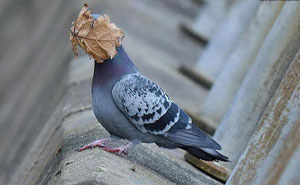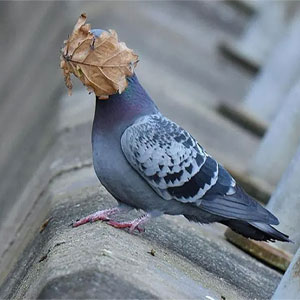Humor flies, and funny bird names prove this fact to be right! With so much attention given to the more fearsome falcons, hawks, and eagles, we forget the little guys. The Little Bustards and Tiny Sky-Tyrant act like the warm-up gigs. People laugh at and disrespect them for the simple fact that the funny bird's name exists. However, it is not their fault for having such a name!
Scientists and other intelligent people give funny bird names for newly found species. For the most part, the names come up from characteristics or already established terms. Sometimes, it is the barrier of language that results in a wrong translation of the name. So, while the creature might have a fearsome name in Latin when translated to English, the funny bird's name ruins that image.
However, these names don’t come from thin air. Instead, scientists take the time to consider the bird's characteristics before coming up with a name. Learn more about his process down below. However, you can always rush down and check out the funny bird names. Don’t agree with the list? Upvote the birds that you liked. Found the bird you hate? Comment down below!
How Scientists Create Funny Names For Birds?
Animal names are a combination of different characteristics. Birds are no exception. If looking at it scientifically, the names might seem more serious. For example — Eurostopodus diabolicus. Sounds cool and dangerous? Well, if translated to English, then you get Satanic Nightjar. And believe us — it’s not some satanic bird.
Latin plays an important role in the name. The Satanic Nightjar part comes from how English speakers interpret the Latin name. Also, the bird makes a “plip-plop” sound. If you ever heard water drip, you might recognize it. However, the local people instead link the sound to pulling a human eye from the head.
This post may include affiliate links.
Satanic Nightjar
Regardless of the name, satanic nightjars don't run cults or offer sacrifices. It's just a medium-sized, greyish brown spotted bird. It was discovered about 90 years ago in Sulawesi (and then re-discovered in 1996). It earned its name because locals believed it was a demonic entity due the sounds it lets out at night.
Boobies
Boobies are the bird species that can be singled out for their bright blue feet (a feature only the males have, and the bluer they are, the better!). The feet are used to attract prospective mates by performing a high-stepping strut, so the species incorporate a performance with the visuals.
Little Bustard
Little bustards are one of the larger birds on this list, despite what its name might suggest. Usually fairly quiet and unobtrusive, males preparing for breeding have distinctive plumage with a black neck and double V-shaped white collar. However, the population of these birds is decreasing.
In France we are more savage. "Outarde canePETière", "pet" means "farts", because this bird make fart noises. https://www.youtube.com/watch?v=MmLPXeY2HT4 Maybe it's for the same reason that they are little "bustards" in English.
Dickcissel
Dickcissels typically can be found in the North American prairies. They eat seeds and are ground foragers, and when it's time to migrate, they can flock in large numbers, sometimes reaching thousands, and while wintering, those flocks can number in the millions.
Tiny Sky-Tyrant
Go-Away-Bird
Go-away-birds are known for their long tails that flop up and down while in flight. They tend to stick to small groups and like to perch on trees and bushes. But their name comes from their nasal sound that sounds very much like “go-waaay,” which earned them the name.
What Should I Name My Bird?
When it comes to the naming process, the process is the same as with a baby. The weirder (and funnies), the better. Go outside and maybe use funny bird names of the species variety. Take a name that best suits your bird to make the humor factor more potent. If you have a crow pet, name him Little Bustard. You’re not making fun of him or calling him a vulgar name. Instead, you will sound scientifically intelligent.
Or, if you are an extravert, call your parrot Go-Away-Bird. They look alike, so the name perfectly suits your flying pal. Also, if you teach your parrot to talk, teach him the phrase, too. So, the next time your parrot says “Go Away” — he's just referring to his name. Nothing too controversial.
Penduline Tit
Penduline tits live up to their name, making elaborate bag nests which they hang from trees near water. They even use spiderweb, animal hair and soft plant materials to create the nest. The construction even has a false opening that leads to a false chamber, and the true interior of the nest is hidden behind a secret door.
Horned Screamer
National Geographic aptly titled horned screamers the unicorns of the bird world. It's the only horned bird in the world, but the horn is not used for fights—it's only ornamental. The horn is loosely attached and will snap off when it grows too big, and then later, it grows back.
Fluffy-Backed Tit-Babbler
The fluffy-backed tit-babbler is a near-threatened species found in Brunei, Indonesia, Malaysia, and Thailand. Their preferred habitats are facing deforestation or similar forms of conversion, causing the species to decline.
Sad Flycatcher
Despite the name, the sad flycatcher is not sad in any way. It does have a small bill, but that's not enough to discourage this woodland species. These birds are native to Jamaica and prefer to stick to various forests.
Smew
Smews are diving ducks that live in northern Europe and Asia. They are migrating birds, meaning they will leave their natural habitat to spend winters somewhere else in order to escape colder climates. It is male smews that have the distinct white-and-black plumage.
Tiny sky-tyrant
Sombre Tit
The sombre tit lives in southeast Europe and southwest Asia. These birds make their nest in the holes of the trees, such as juniper or willow, and they lay eggs twice a year. The species also appears to be somewhat stationary, with slight local movements, and they don't migrate half a world away.
What is the Funniest Bird Name?
Humor is subjective, and the variety of funny bird names proves it. However, when it comes to the funniest one, it has to stick like the weird human names. To some, humor comes from the names that sound similar or exactly like body parts (not going to mention them here). To others, the punchline is the phrase hidden behind the name. Either way, take the time to look at the species names that are proven comedy gold.
Typical Swift
The typical or common swift follows its name to the letter. Their feathers are in dark colors, with no outrageous features, but it lives up to the swift title, spending as much as ten months per year in continuous flight. Germans even call this bird "wall-glider" as a tribute to its ability to cling to vertical surfaces.
European Shag
European shags can be found in western Europe and northern Africa. There are three subspecies: living in the north (like Iceland), in mild climates (such as the central Mediterranean), and those preferring warm weather (like the coasts of northern Africa).
Rough-Faced Shag
The rough-faced shag is a rare species from New Zealand. For close to 200+ years, their small population was confined to four islands in the Marlborough Sounds area, and due to this, these birds are considered vulnerable. And instead of exquisite singing, this bird lets out croaking noises.
Common Loon
Common loons are water birds, often found near coastal waters. They catch fish underwater, using their feet as a propeller. They are fast swimmers and equally fast fliers and can reach speeds of 70 mph. Fun fact: in order to fly, these birds need to have a running start, not unlike a plane that's about to take off.
Red-Rumped Bush-Tyrant
The red-rumped bush-tyrant can be recognized for its dual coloring. The upper body of the bird is gray, while the belly is bright. It also has extensive rufous webbing on the tail feathers. The species likes a humid environment with plenty of trees.
Noisy Pitta
The noisy pitta can be found in areas of Australia and New South Wales. They are known to use anvils (which can be a polished stone stuck in the ground, a tree stump, or even a broken bottle) to break up food such as snails, which are some of their favorite foods. Some anvils can be used for years, like a long-lasting tool.
Noisy Miner
Noisy miners are not the biggest of birds, but despite that, they aggressively attack larger birds such as hawks. They stick to their aggressive strategy so much that there are very few (if any) other bird species in their territory.
Spangled Drongo
The spangled drongo has glossy black plumage with iridescent blue-green spots (spangles), hence the name. Its blood-red eyes also stand out from the otherwise dark plumage. These birds are not against working together, as often they flock together to 'hawk' flying insects for food.
Hoary Puffleg
Hoary pufflegs are rare South American hummingbirds. They can be found in areas of the Andes and northwest Ecuador. They prefer evergreen forests at a 1,100-2,500 m altitude. Due to their limited range and declining population, they are considered a threatened species.
Hoary is a perfectly cromulent word! When Ubuntu named their versions as alliterative adjective+animal pairs (like Breezy badger and Maverick meerkat) there was Hoary Hedgehog so I had to look up the word.
Swallow
Swallow is a very broad name encapsulating approximately 90 species. These birds are not very big, and often have dark plumage. They are very agile and spend much of their time in the air, catching insects. They can be found worldwide, and more distinct features depend on specific species.
Ruddy Pigeon
Ruddy pigeons can be found in Costa Rica, Ecuador, and Brazil, and they prefer higher, 1500-meter altitudes. They can be recognized by their unpatterned and mainly wine-purple color of the feathers. The species can often be noticed in pairs, searching for fruits and berries.
Drab Seedeater
The drab seedeater is found in South America, typically in Ecuador and Peru, and luckily, they are not facing any form of extinction. They like subtropical or tropical shrublands, and the birds themselves don't have any distinct features, hence the name "drab."
Perplexing Scrubwren
Perplexing scrubwrens live in Indonesia and Papua New Guinea, preferring moist lowland forests. The species' perplexing name arose due to the difficulty it causes while trying to classify it, since living in some areas, this bird interbreeds with larger scrubwren species, and while living in other regions, it doesn't display this behavior.
Monotonous Lark
The monotonous lark earned its name due to the males insistently singing a croaking, gurgling, distinctive four-note song every 3-5 seconds for hours, regardless of whether it's day or night. While singing, the bird will puff out, stretch its neck, and raise a small crest.
Given that larks are renowned for their fanciful singing, this isn't that weird a name for the black sheep of the family?
Noisy Friarbird
Noisy friarbirds are sometimes referred to as "leatherheads" because of their bare black head. However, despite this species' appearance, they are honeyeaters and you can often spot them in the outer canopy of flowering trees, especially eucalypts.
In my part of the world, the only birds without feathers on their heads are carrion-eaters. It's interesting to know that there are some birds which aren't! At first glance I thought it was a teeny-tiny Turkey Vulture.
Noisy Scrub-Bird
The noisy scrub-bird earned its name for the loud song it performs. Its territorial call starts pleasantly enough, and ends with an ear-splitting finish. It can be found in Western Australia, but its habitat greatly decreased because of the wildfires.
HOW CAN YOU HATE BIRDS? ~ *edit* Seeing as the title of this thread was changed, this comment seems redundant... whatever
I love all the bird names but I hate the captions mocking men for not going to therapy. Really? You could've just enjoyed some funny bird names, but instead you just had to go out there & stigmatize men's mental health more than it already is. Also, ANYONE can have an immature sense of humor, not just men. I'm sure plenty of women found this article funny too. Let's quit the toxic masculinity, okay? Just enjoy the damn birds.
I can imagine- back in the olden days- a father taking his son on his knee. "So son," he says. staring seriously into his son's eyes, "Your Daddy found a new birdy today." The boy opens his mouth in suprise. "You mean it Daddy?!" He squeals, bouncing on his fathers knee. "Yes. You can finally get to name a bird. You are my son, after all." The son looks into his fathers eyes, "How about (fill in random name from the list above)?" "Tremendous," the father says, ruffling his sons hair. "Just wait till we tell your mother." I hope you enjoyed how much my attention wandered. XD
My dad is an avid birdwatcher, so I know a few more... Andean c**k-of-the-rock, Bananaquit, Orangequit, Whip-poor-will , Chuck-will's-widow , Killdeer, Ovenbird... and Theres probably more but those are the amusing ones off the top of my head. I feel sorry for will though, Ornithologists hate him. First they whipped him, then they presumably killed him and chucked his widow out the window or something. :(
These were named before our society became disgustingly immersed in sex obsession and saw dirty meanings everywhere. Maybe we should take a look at ourselves instead.
HOW CAN YOU HATE BIRDS? ~ *edit* Seeing as the title of this thread was changed, this comment seems redundant... whatever
I love all the bird names but I hate the captions mocking men for not going to therapy. Really? You could've just enjoyed some funny bird names, but instead you just had to go out there & stigmatize men's mental health more than it already is. Also, ANYONE can have an immature sense of humor, not just men. I'm sure plenty of women found this article funny too. Let's quit the toxic masculinity, okay? Just enjoy the damn birds.
I can imagine- back in the olden days- a father taking his son on his knee. "So son," he says. staring seriously into his son's eyes, "Your Daddy found a new birdy today." The boy opens his mouth in suprise. "You mean it Daddy?!" He squeals, bouncing on his fathers knee. "Yes. You can finally get to name a bird. You are my son, after all." The son looks into his fathers eyes, "How about (fill in random name from the list above)?" "Tremendous," the father says, ruffling his sons hair. "Just wait till we tell your mother." I hope you enjoyed how much my attention wandered. XD
My dad is an avid birdwatcher, so I know a few more... Andean c**k-of-the-rock, Bananaquit, Orangequit, Whip-poor-will , Chuck-will's-widow , Killdeer, Ovenbird... and Theres probably more but those are the amusing ones off the top of my head. I feel sorry for will though, Ornithologists hate him. First they whipped him, then they presumably killed him and chucked his widow out the window or something. :(
These were named before our society became disgustingly immersed in sex obsession and saw dirty meanings everywhere. Maybe we should take a look at ourselves instead.

 Dark Mode
Dark Mode 

 No fees, cancel anytime
No fees, cancel anytime 


















































































